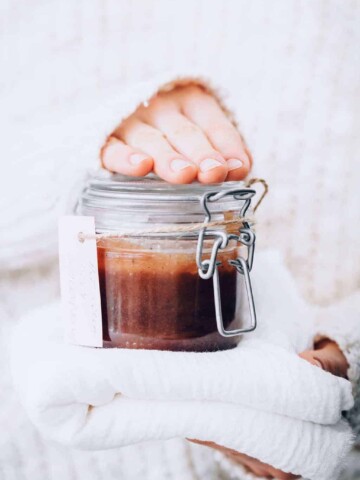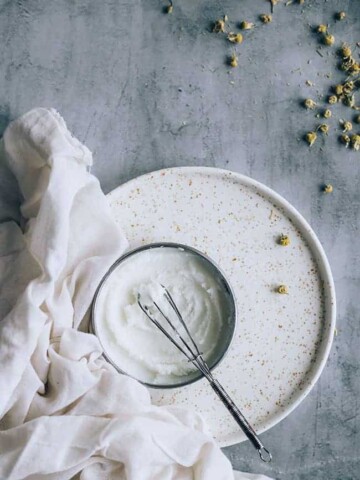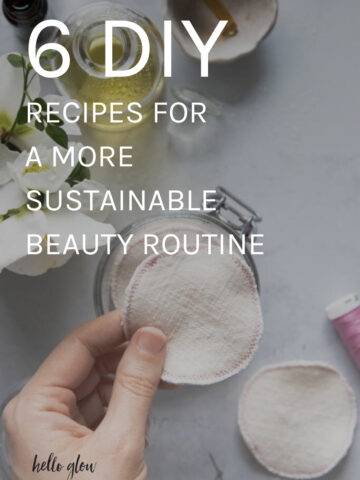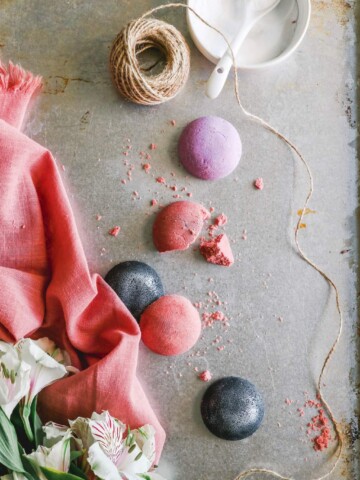We've all been there and experienced that hot, painful feeling after too much time in the sun. That's why natural sunburn remedies are a must-have! These simple recipes will go a long way in soothing irritation, preventing peeling (ugh), and keeping your skin hydrated.
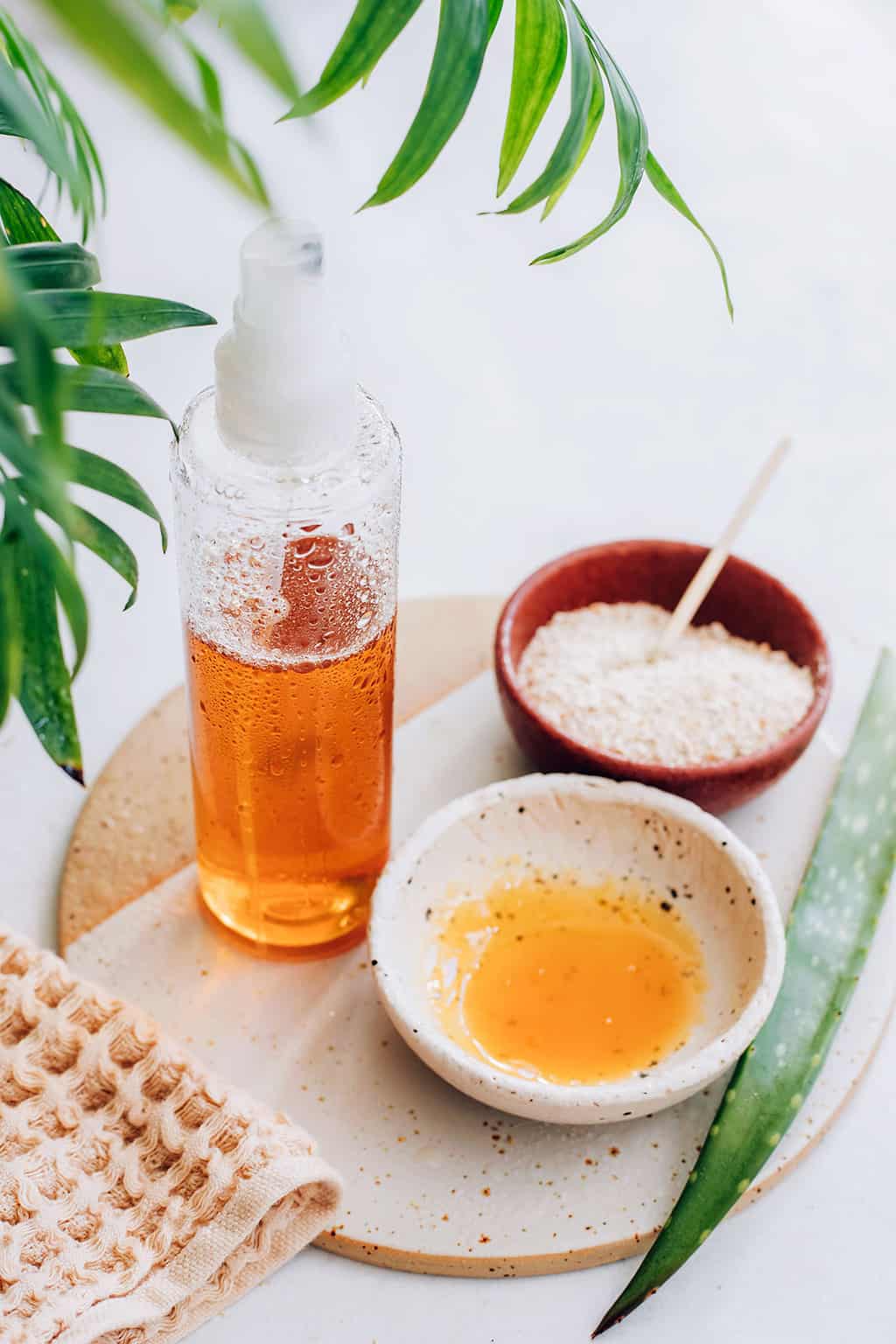
After a long weekend in the sun, you may need a natural sunburn relief remedy! Despite applying sunscreen, wearing hats, and avoiding the hottest part of the day, it’s inevitable that I overdo it once or twice each summer.
I’m good about putting on sunscreen—it’s the reapplying that I always forget! But I have to remind myself that the hot and painful feeling that comes with a sunburn is so unpleasant—not to mention its aging effects on the skin.
Jump to:
DIY Sunburn Remedies
These sunburn home remedies use natural anti-inflammatories to help take the heat out of your sensitive skin. And don’t forget to drink plenty of water and moisturize, moisturize, moisturize!
1. Take a Cool Bath
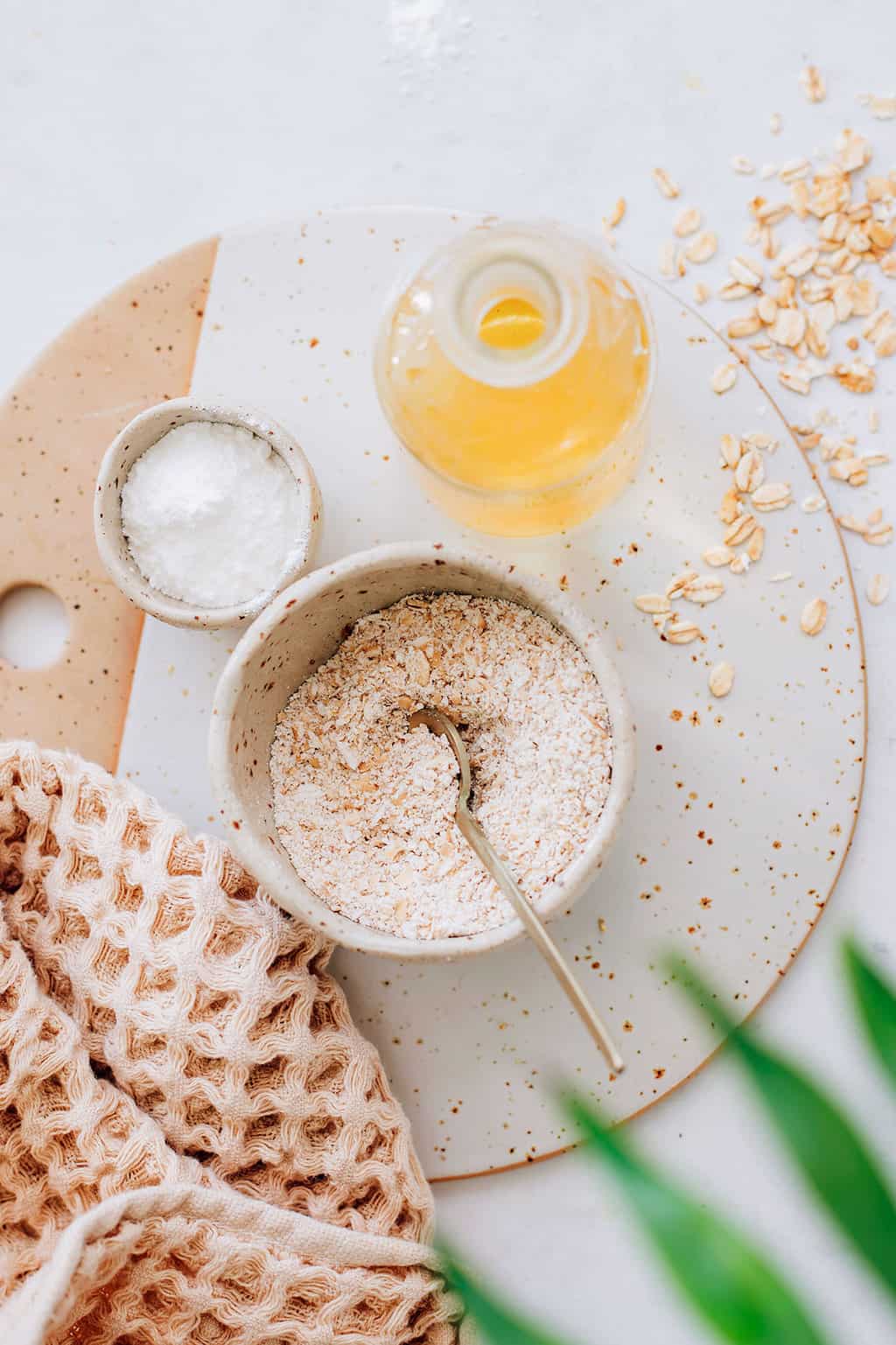
Take a cool bath or shower to help soothe the burn. You can also use cool, damp cloths on the affected areas.
Oatmeal baths are actually a very old remedy for irritated skin conditions—usually eczema and psoriasis—but they still work well to soothe sunburn.
Oatmeal is rich in beta-glucan [source], a super skin-friendly molecule that helps to soothe and increase moisture in the skin [source], supporting its natural healing processes for a sunburn that goes away faster.
Adding baking soda and ACV to a bath also eases sunburn pain, itching, and inflammation.
Ingredients
- 1 cup oats, ground
- ½ cup baking soda
- ¼ cup apple cider vinegar
Instructions
1. Combine ground oats and baking soda in a sealed container.
2. Draw a warm bath (as cool as you can stand) and add ¼ cup of the baking soda oat mixture along with the apple cider vinegar.
3. Keep your soak no longer than around 15 to 20 minutes, or you risk drying out the skin even more.
4. Then generously slather all tender areas with an alcohol- and fragrance-free lotion (like this one with compounds that help restore the skin barrier), coconut oil, or aloe vera.
Don't have oats? Try these sunburn bath options:
Add 1 to 2 cups of any of the following ingredients (or a combination of them) to a lukewarm bath.
- Witch hazel (just make sure it's alcohol-free)
- Cucumber juice
- Dairy (milk, yogurt, or buttermilk): A milk bath can calm the heat from the sunburn while its proteins work to reduce inflammation and soothe the skin.
- Baking soda bath
- Apple cider vinegar bath: Dilute ¼ cup ACV in 2 cups of water, then add to the bath.
- Tea baths with chamomile, mint, or green tea: Bring 2 cups of water to a boil. Remove from heat and add 1 tea bag per cup of water (you can use 2 of one kind or combine them). Steep for 15–20 minutes. Remove tea bags, let it cool slightly, and pour the freshly-brewed tea into the bath.
2. Hydrate Skin with Cooling Cucumber Lotion
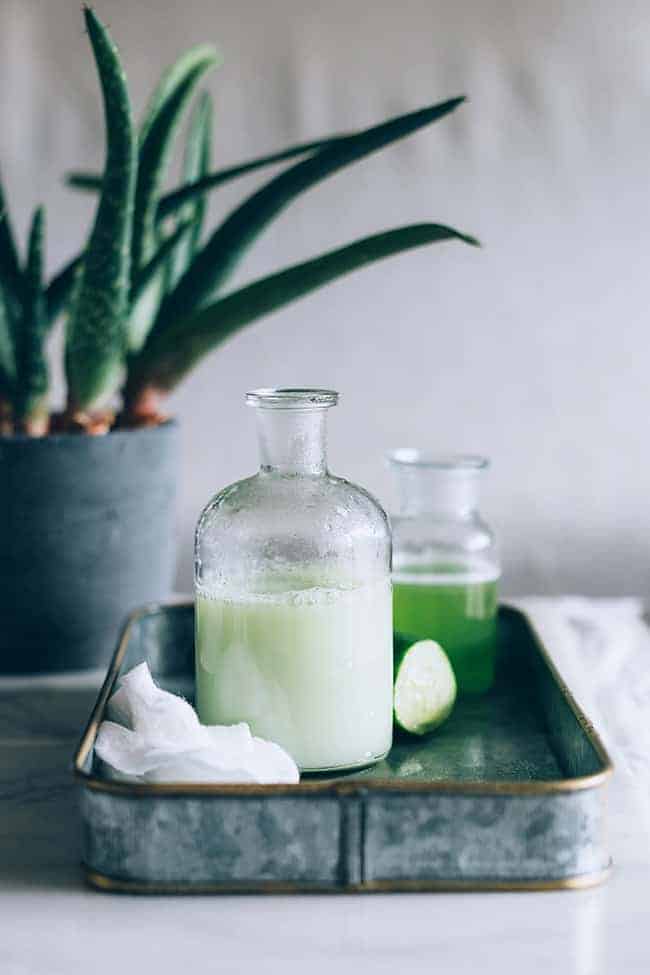
If you (or the kids) won’t sit still for a compress, a cooling sunburn lotion is a great solution. It soothes lobster-red skin with anti-inflammatory compounds and adds much-needed moisture.
Cucumbers are one of nature’s best anti-inflammatory agents! They are naturally cooling, and animal research has proven they help with pain control [source].
Adding aloe vera provides more cooling, anti-inflammatory relief that takes the sting out of a sunburn [source]. Keep it in the fridge for extra cooling relief!
Ingredients
- 1 cucumber
- ¼ cup coconut milk
- ¼ cup aloe vera juice
Instructions
1. To juice the cucumber, coarsely grate it and place in a strainer or cheesecloth over a bowl. Press down on the cucumber to release its juice. I got almost a cup of juice from just 1 cucumber!
2. Pour into a lidded container and add the coconut milk and aloe vera juice. Shake to combine. Keep refrigerated.
3. You can apply to the skin with a spray bottle or by wetting a wash rag and applying to irritated areas.
3. Spritz on Aloe Spray

I love this version of my favorite sunburn spray—spritzing it on when just out of the fridge feels so good on hot, parched skin!
Aloe has antioxidants that soothe irritated skin and help heal sun damage [source]. And the healing anti-inflammatory and anesthetic action of lavender soothes the skin after sun exposure [source].
The moisturizing ingredients minimize peeling, although you may want to up the moisture content by applying some pure coconut oil on top.
Ingredients
- ¼ cup aloe vera gel
- ¼ cup lavender hydrosol
- 1 tablespoon fractionated coconut oil
- 10 drops lavender essential oil
Instructions
1. Add coconut oil to a 4-ounce spray bottle, and then add the lavender hydrosol and EO drops. Pour in the aloe vera and witch hazel and swirl to combine.
2. Shake the bottle and then pray liberally onto targeted areas in need of after-sun soothing.
4. Soothe a Sunburned Face with an Aloe Face Mask
My nose and cheeks are always the first to burn. That’s possibly why I have more than my share of freckles and age spots in those areas!
A soothing aloe face mask with healing honey will help bring down the redness. Aloe works as an anti-inflammatory on reddened skin, provides cooling relief, and is one of the most commonly used ingredients for minor burns [source].
Raw honey is another natural healer, and it acts as a humectant to draw moisture into dry skin [source]. This combination promotes skin healing and will calm down a burn.
Ingredients
Instructions
1. Combine the ingredients and apply the mask to your face and any other sunburned areas.
2. Of course, prepared aloe vera gel is fine to use for this, but having an aloe plant around is always really handy. To harvest the gel, just carefully break off the leaf, then peel and put the raw gel into a blender to get a smooth consistency before use.
5. Apply an Itch-Relieving Compress
I know what you’re thinking: vinegar? On a sunburn? This soothing compress helps to take down the itching—there’s nothing worse than trying not to scratch a healing, peeling, itchy sunburn, right?
The acetic acid in apple cider vinegar provides pain relief, while baking soda soothes itchy skin.
Ingredients
- ¼ cup apple cider vinegar
- ¼ cup baking soda
- Several drops of a sunburn soothing essential oil like geranium [source] or lavender [source]
Instructions
1. Combine ingredients to make a paste.
2. Apply directly to the sunburned areas, or use a soft cloth to make a compress. This also works for bug bites!
What To Put on a Sunburn
Not sure what to put on a sunburn after you've taken a cool bath and tried aloe? Here are some other ways to treat your sunburn at home:
- Moisturizer: After cooling the skin, be generous with a moisturizer like this cocoa butter balm or an oatmeal lotion to seal in hydration and help prevent flaky skin. Avoid creams with petroleum, benzocaine, or lidocaine, which can irritate the skin or cause allergic reactions.
- Hydrocortisone Cream: Over-the-counter hydrocortisone cream can reduce inflammation and itching. It's useful for more uncomfortable or swollen sunburns.
- Hydration: Drink plenty of water as sunburns can dehydrate you.
- Anti-inflammatory Medications: Oral non-steroidal anti-inflammatory drugs (NSAIDs), such as ibuprofen or aspirin, can help reduce swelling, redness, and discomfort.
- Cool Compresses: Applying cool compresses — a towel dampened with cool water — to the affected areas can also be soothing.
References
Henrion M, et al. Cereal B-glucans: the impact of processing and how it affects physiological responses. Nutrients. 2019.
Du B, et al. Skin health promotion effects of natural beta-glucan derived from cereals and microorganisms: a review. Phytother Res. 2014.
Boukhatem MN, et al. Rose geranium essential oil as a source of new and safe anti-inflammatory drugs. Libyan J Med. 2013.
Da Silva GL, et al. Antioxidant, analgesic and anti-inflammatory effects of lavender essential oil. An Acad Bras Cienc. 2015.
Radha MH, et al. Evaluation of biological properties and clinical effectiveness of Aloe vera: a systematic review. J Tradit Complement Med. 2015.
Kumar D, et al. Free radical scavenging and analgesic activities of Cucumis sativus L. fruit extract. J Young Pharm 2010.
Surjushe A, et al. Aloe vera: a short review. Indian J Dermatol. 2008.
McLoone P, et al. Honey: a therapeutic agent for disorders of the skin. Cent Asian J Glob Health. 2016.
This article was medically reviewed by Dr. Gina Jansheski, a licensed, board-certified pediatrician with more than 20 years of practice experience. Learn more about Hello Glow’s medical reviewers here. As always, this is not personal medical advice, and we recommend that you talk with your doctor.
260

